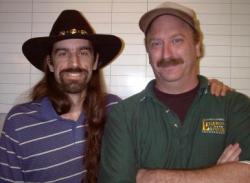|
 "You
see things and you say: 'Why?' "You
see things and you say: 'Why?'
But I dream things that never were and I say: 'Why not?'"
-- George Bernard Shaw
When John F. Kennedy was assassinated, the first bullet that hit him through the throat caused his body to pull up. If instead of going
more erect, his physical impulse would have been to push his head forward toward the floor of the car, the fatal bullet that killed him
would have missed... and Vietnam, Civil Rights, and even Beatlemania would likely have been very different.
This is the story of one of those moments in life where a single different choice could have drastically changed the (poker) world.
When I opened my first poker website in 2000, I asked Chris Ferguson, the reigning World Series of Poker main event champion, to pose for a
photo for the main page of the site, the one shown above. I'd known Chris for at least six years by then. (We made
final tables
together three times in 1994, including one where I came in first and he in second when I had by far the best rush of my life headup.)
We weren't close friends away from the casinos, but he was one of the nicest people I ever met while playing -- which makes his post-2015
actions puzzling and saddening to me. I haven't talked to Chris for over ten years, but all the brouhaha surrounding him these days
takes me back to what might have been.
In January 2001, I was approached at a Commerce Casino tournament by Daniel Negreanu. He asked me if a Canadian acquaintance of his could contact
me with a business proposition. The acquaintance was Isai Scheinberg and the business became PokerStars.com. Thanks to Daniel turning Isai down,
I got the chance to help create
what ended up becoming the largest online poker room in the world. Thanks, Daniel! (As most anyone reading this knows, Daniel ended up joining
the company several years later, and became the primary "face" of the company.)
By early 2002, I had been working with PokerStars for over a year. We had been open for real money for several weeks. That meant we
were now looking to hire experts/professionals, and personalize the site somewhat. One idea was to establish a player advisory board.
The environment back in 2002 was completely different than today. No person on the street could name any poker player, except for
possibly Amarillo Slim (because of Tonight Show appearances) or Johnny Chan (because of Rounders). Doyle Brunson, Phil Hellmuth, David
Sklansky... nobody outside the poker world ever heard of these guys.
The player advisory board never went anywhere, but one thing that came of it was: Isai asked me to contact Chris Ferguson to see if we
could work out a deal where he would become the face of the company. He was no longer the reigning WSOP champion, but he was well-liked
and had a Ph.D. in computer science. On paper, he made sense.
So I talk to Chris. Chris talks to Isai. Isai talks to me. Isai and Chris talk several more times. At first I thought Chris joining up
would be a good addition, but after our conversations and talking with Isai, it became clear to me that Chris and I had very different
ideas on how to run an online cardroom. The short explanation of the difference is: I thought a very "hands on" entrepreneurial
approach was best (and I think Isai believed this even more so), while Chris offered a much more laissez-faire, "hands off"
philosophy. (I think this hands-off versus hands-on difference is the root of the difference in the
business choices PokerStars made compared to Full Tilt
years later. Check out the linked article for more on those major differences.)
After a few days, it became clear that no deal would be made because of different philosophies and compensation structure ideas.
Chris Ferguson did not become the face of PokerStars -- but we were not all that far apart. Some bending or use of different words
to describe ideas, and a deal could easily have happened... and Full Tilt Poker would never have been founded, no phantom deposits,
no Ponzi scheme, and no destroyed reputation for somebody who at one time was universally liked.
Instead, Chris went away from these negotiations and decided to start his own online poker site...
From small things, big things one day come.
Coincidentally, the Ferguson/PokerStars negotiations occurred about the same time (February 2002) as negotiations for Phil Ivey to become a
sponsored player with Paradise Poker. See
The Saga of Paradise Poker for that story.
The footnote of the story is in the next couple weeks Steve Morrow was hired as the first cardroom manager and Dan Goldman was hired
as the marketing head -- a job which a few months later lead to Dan having the horrifying experience of
dealing with Amarillo Slim after he was offered the opportunity
to become the face of PokerStars.
See also The Most Googled Poker Players During the Boom and
Combining PokerStars & Full Tilt After Black Friday |

